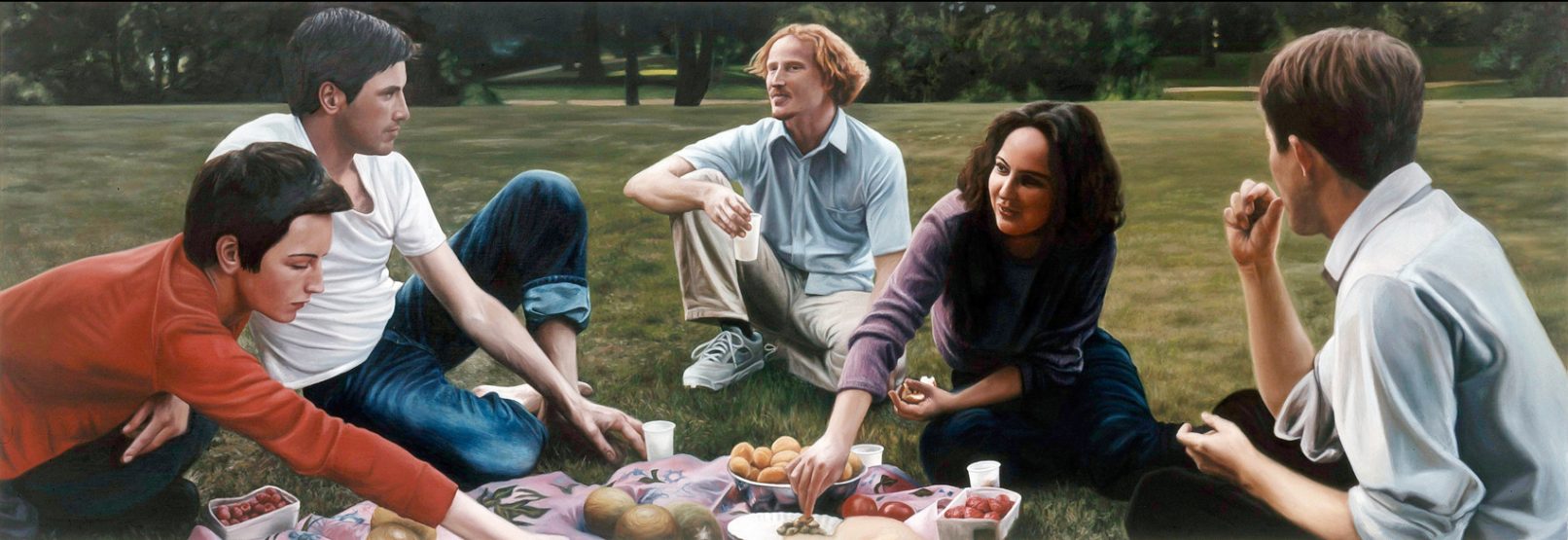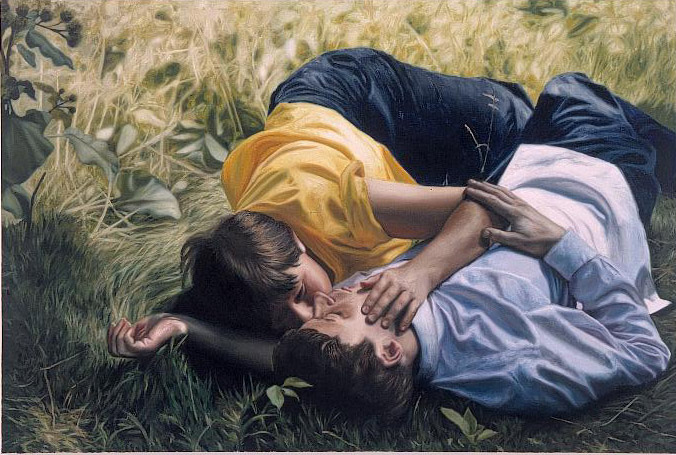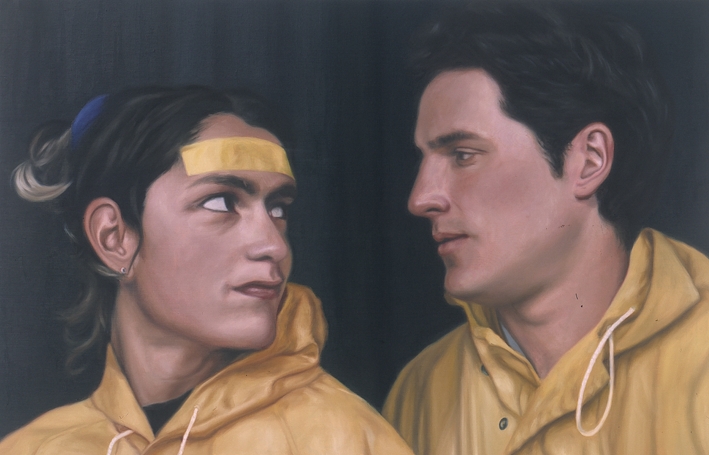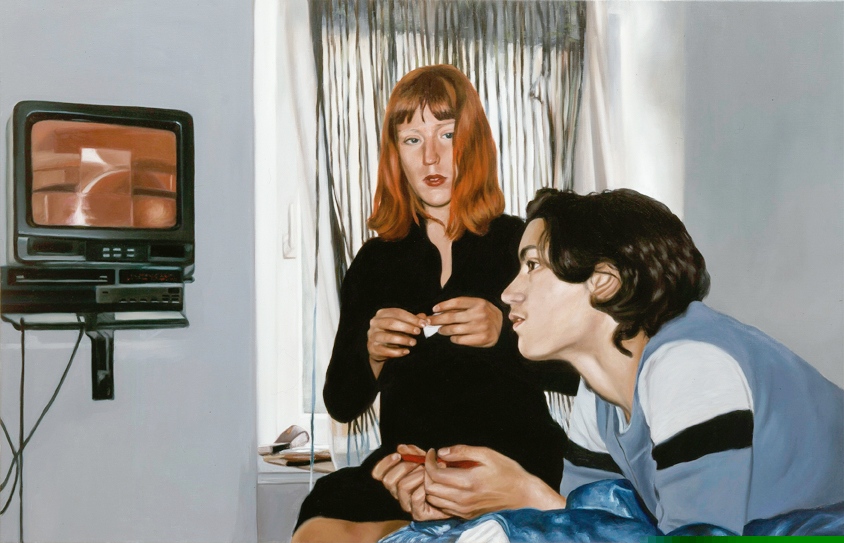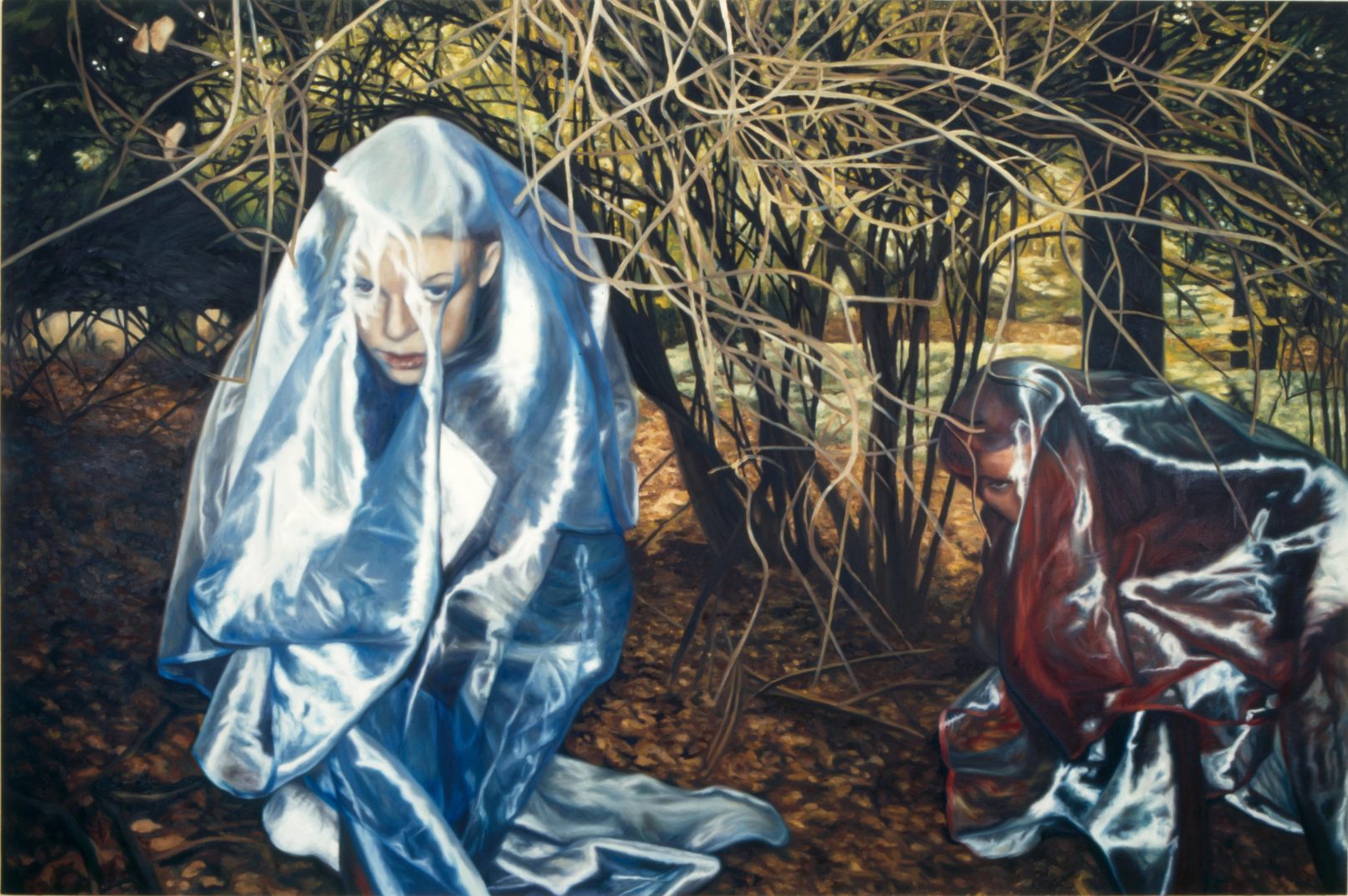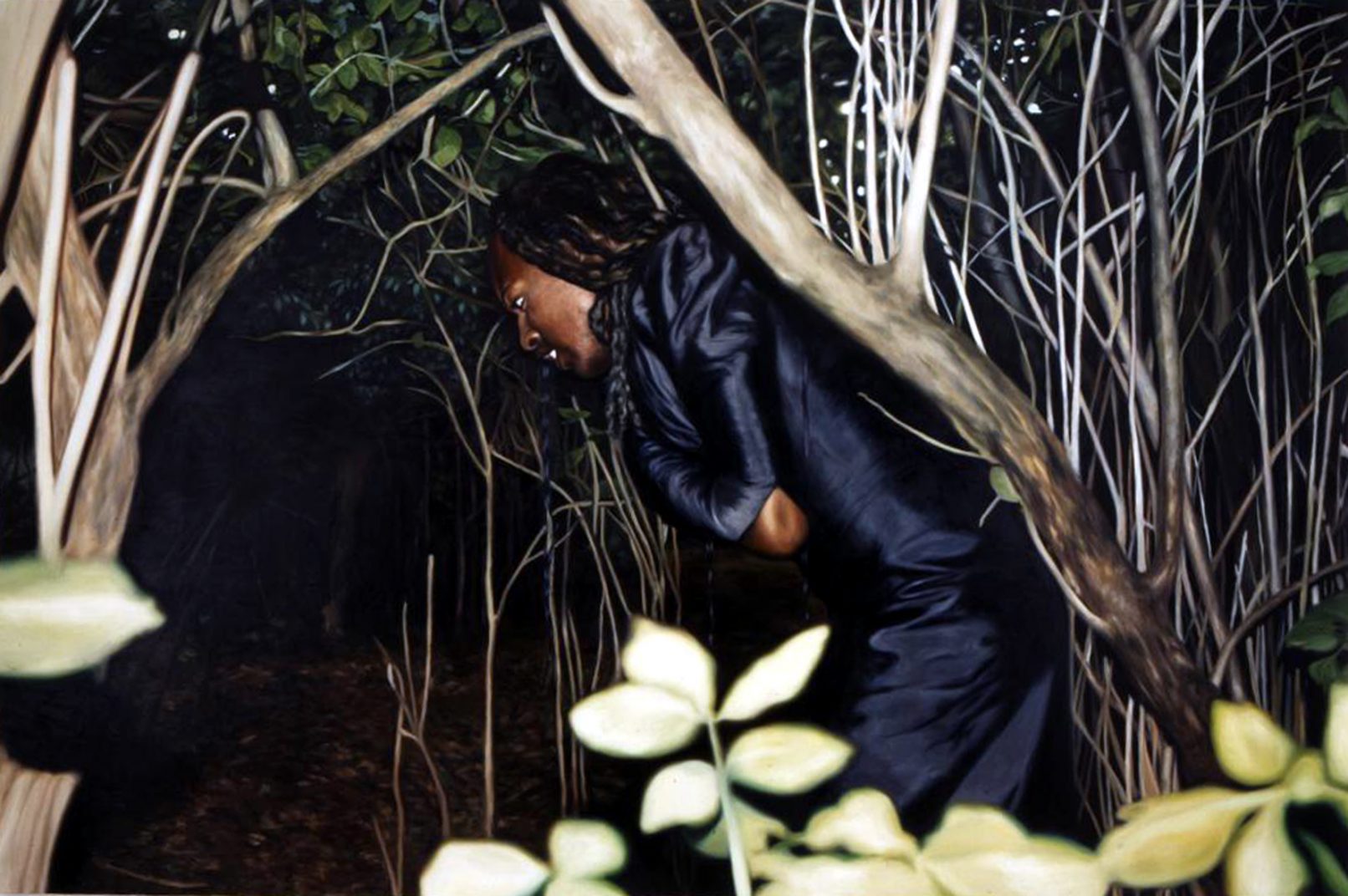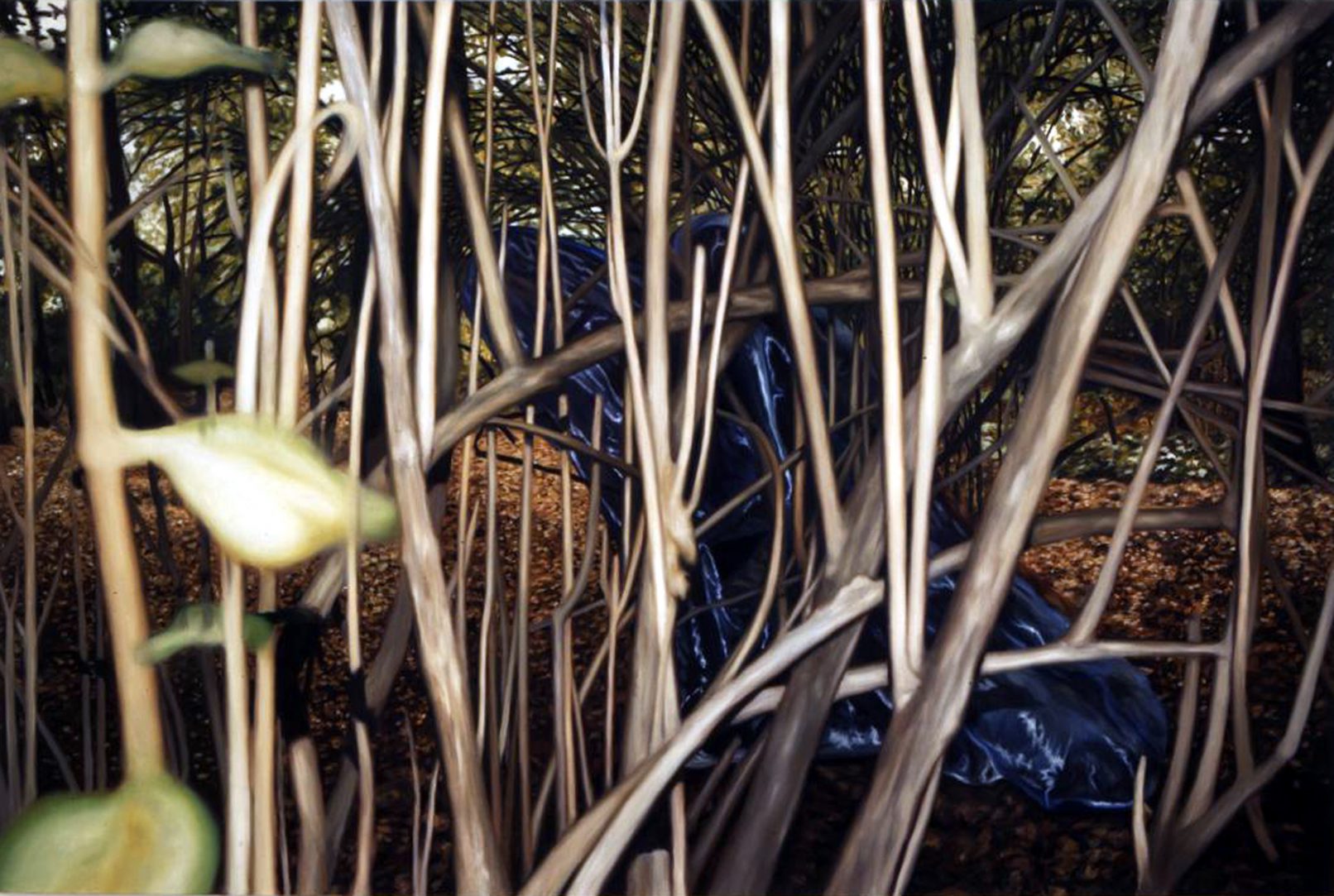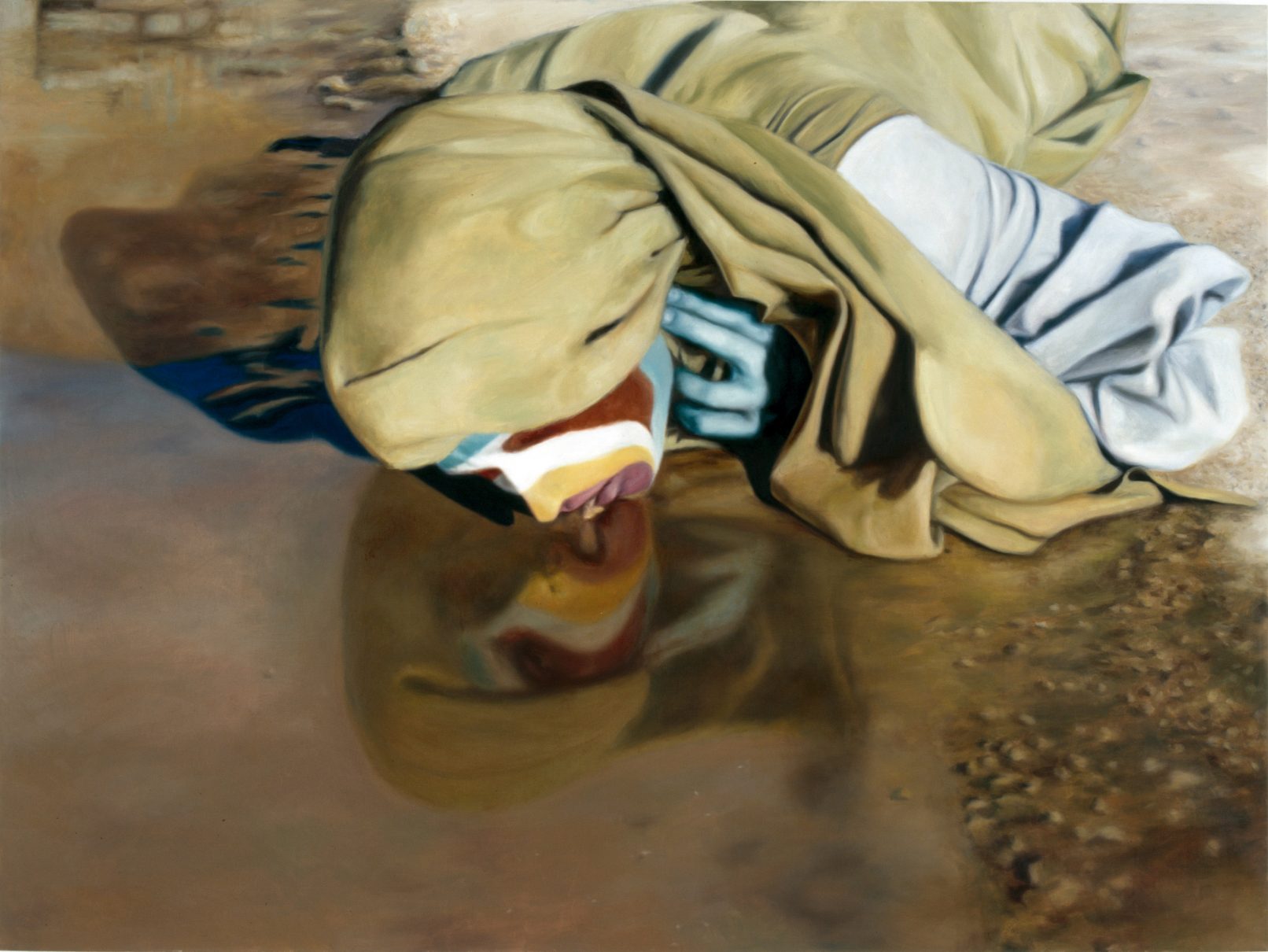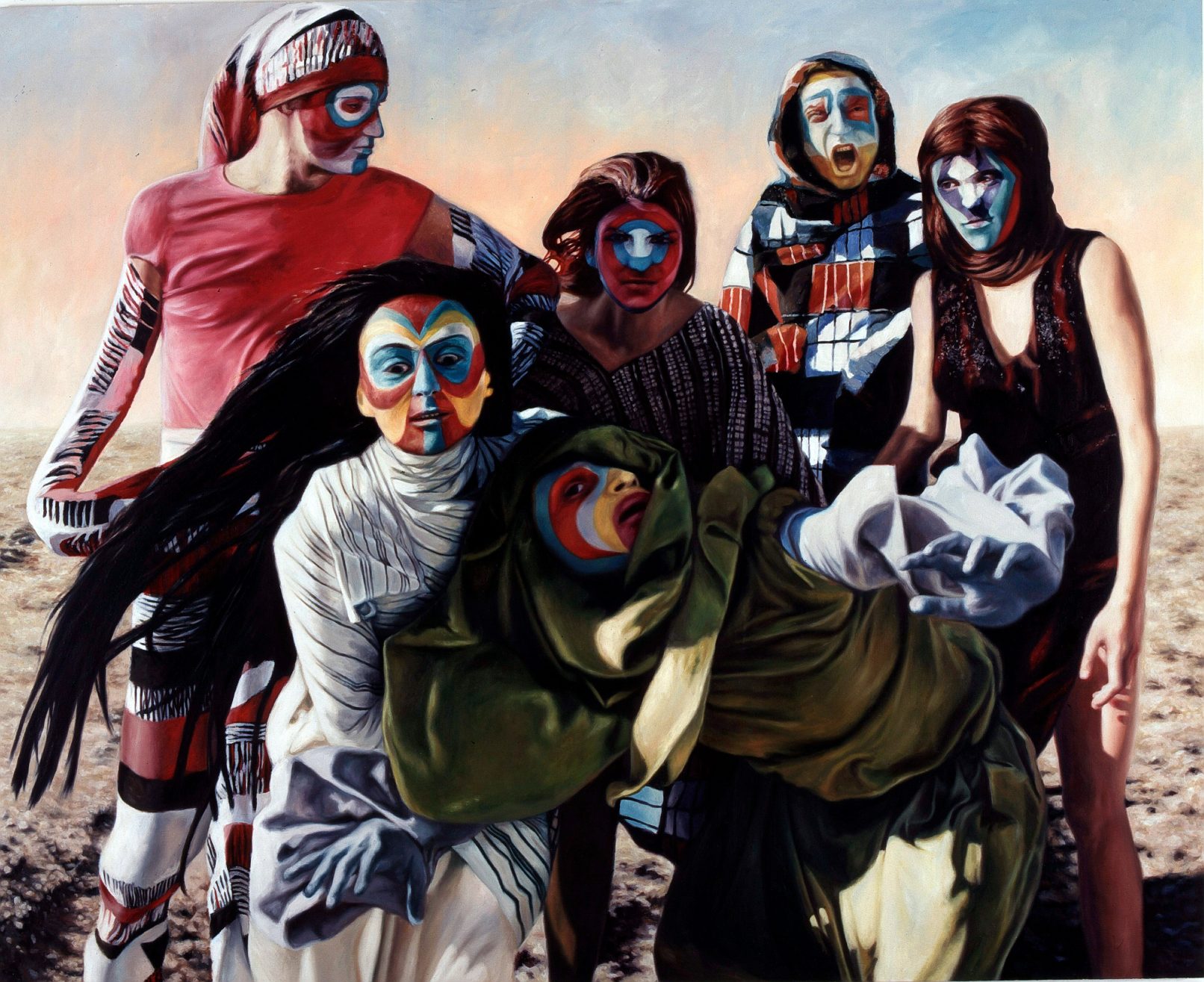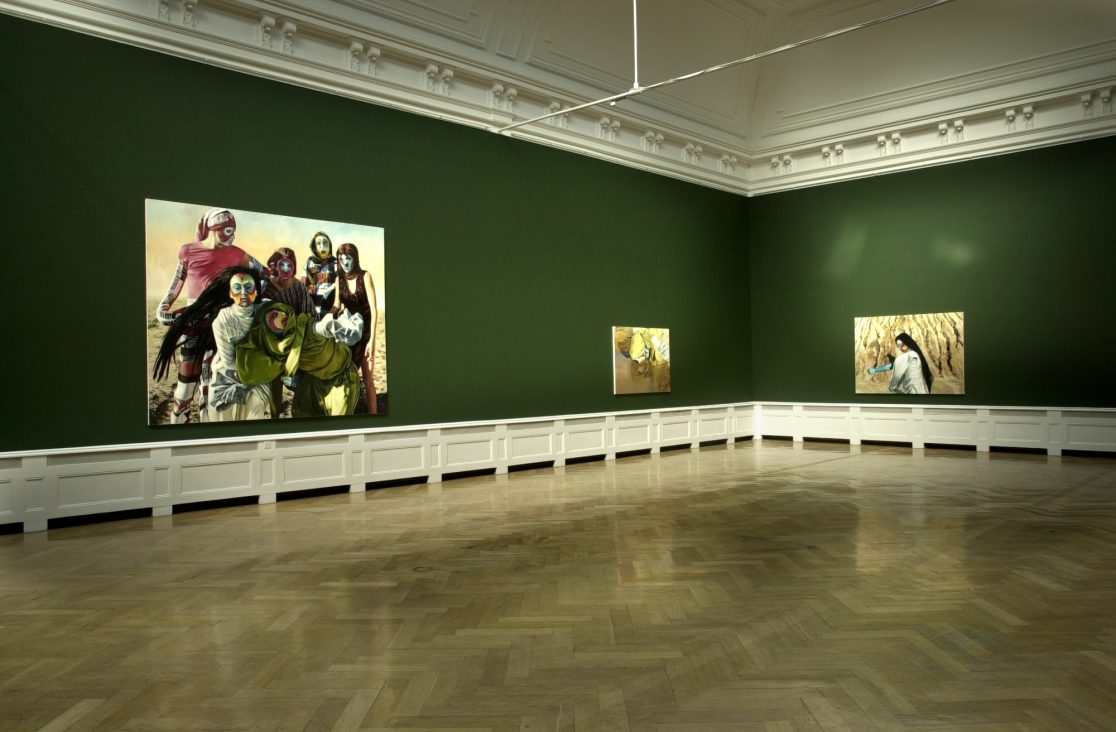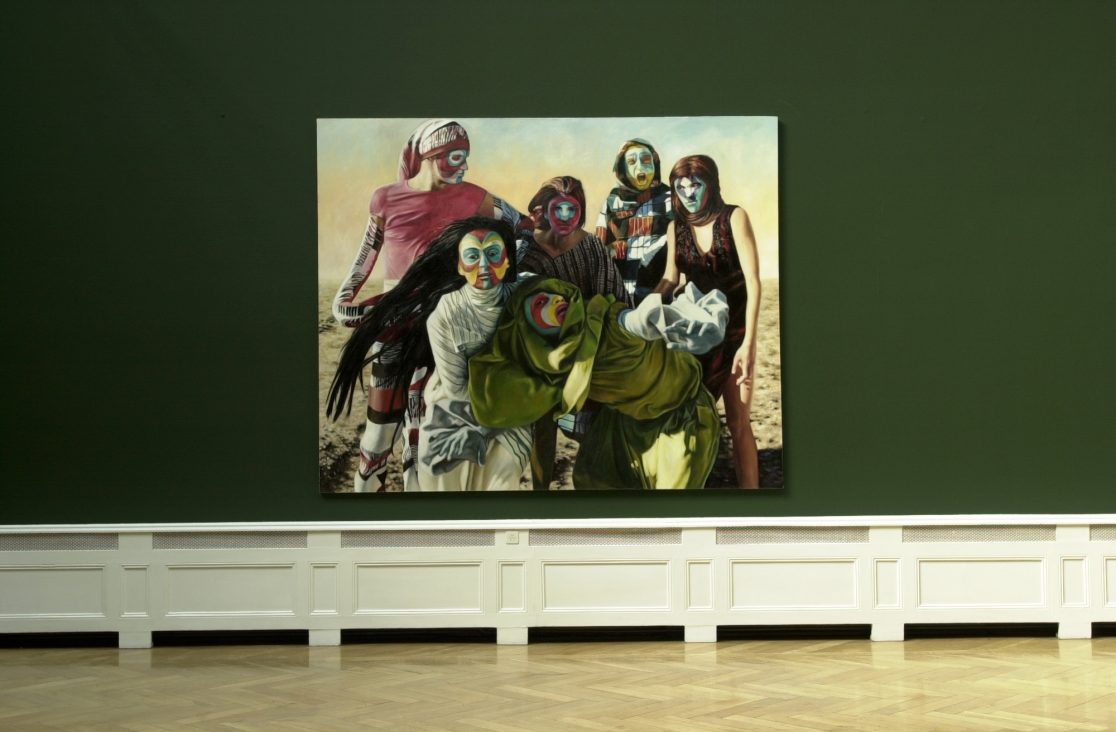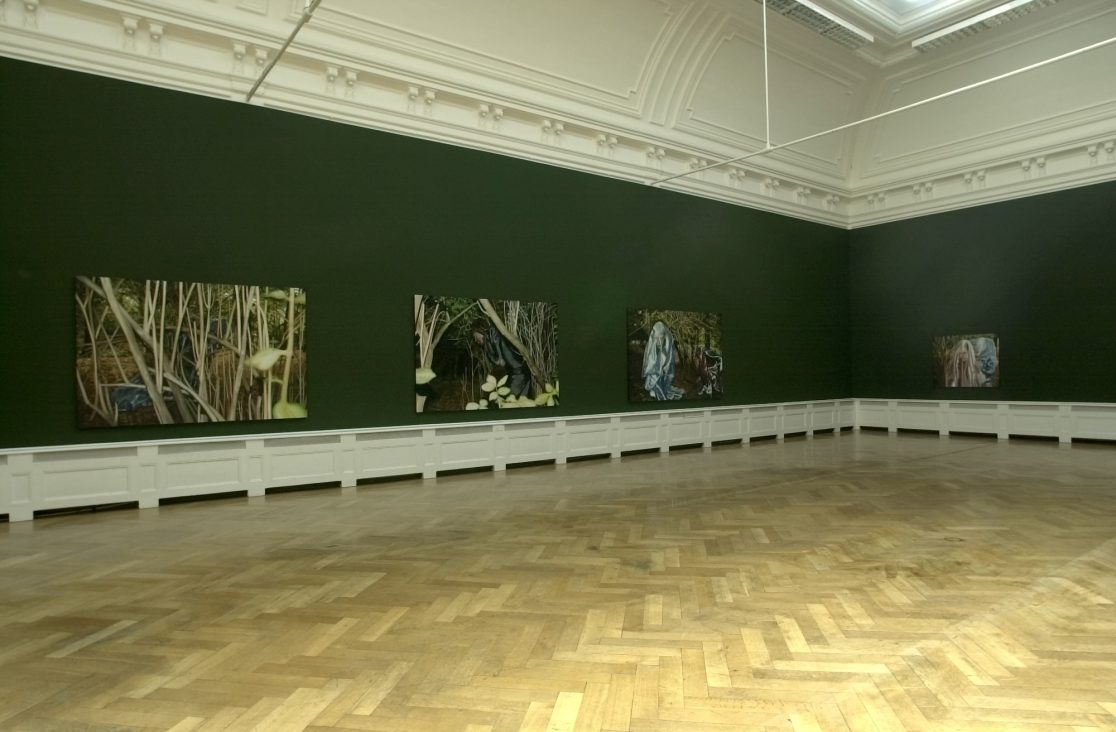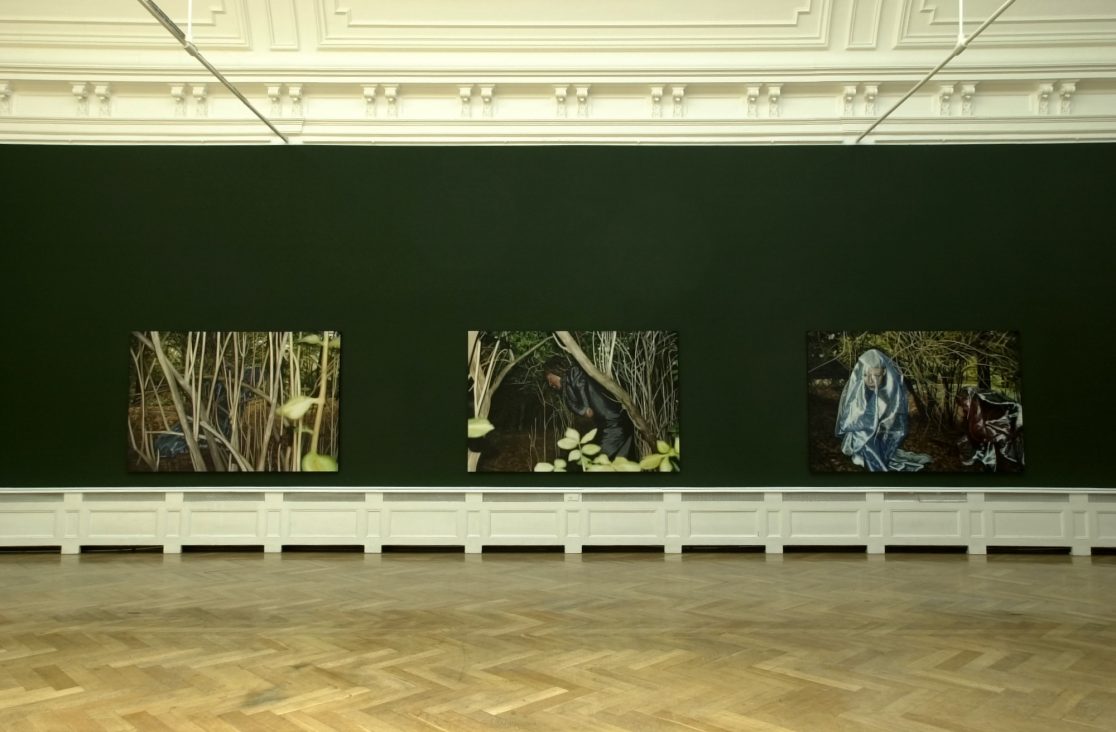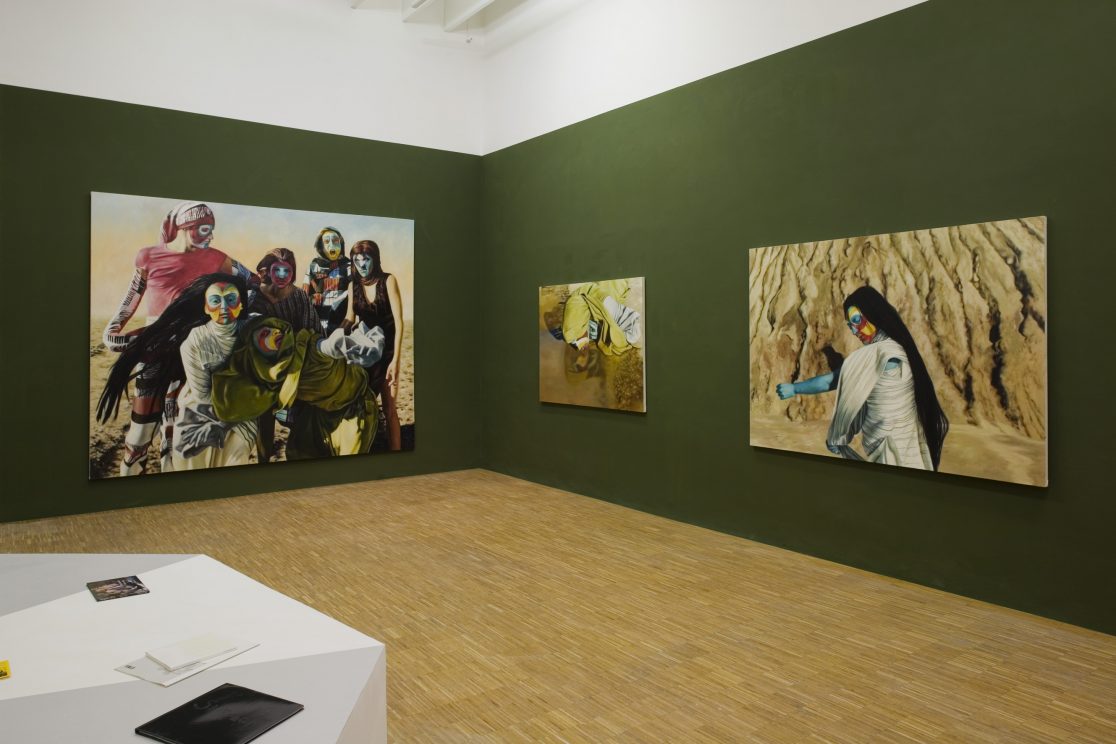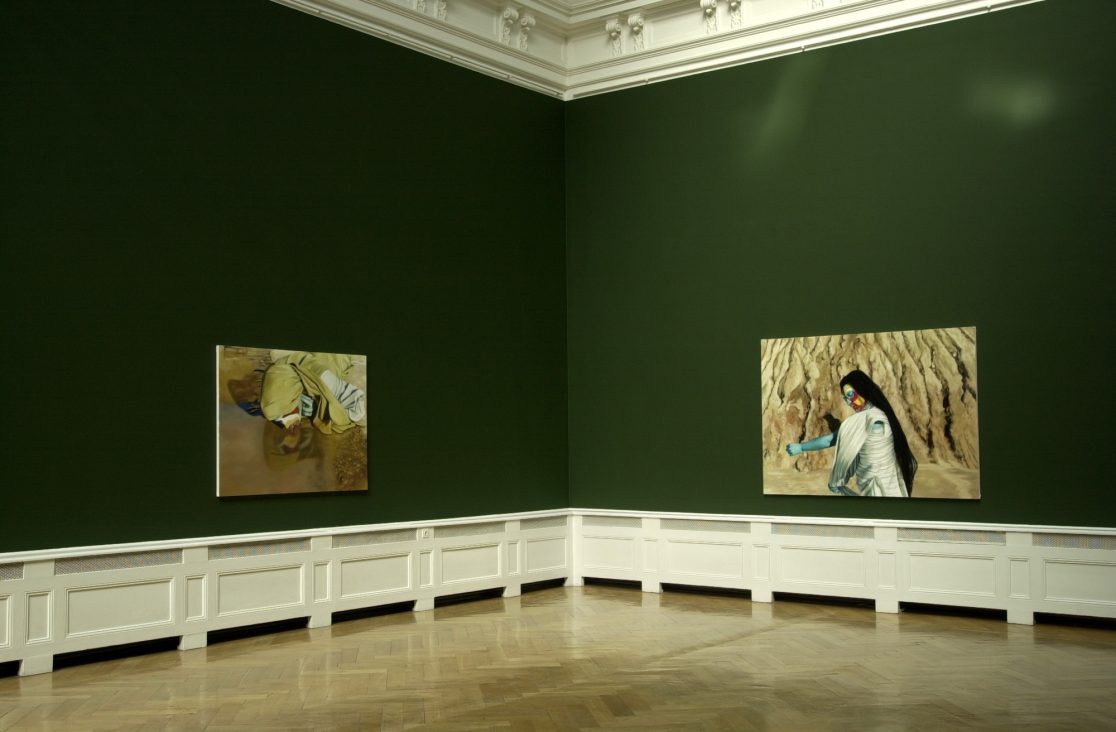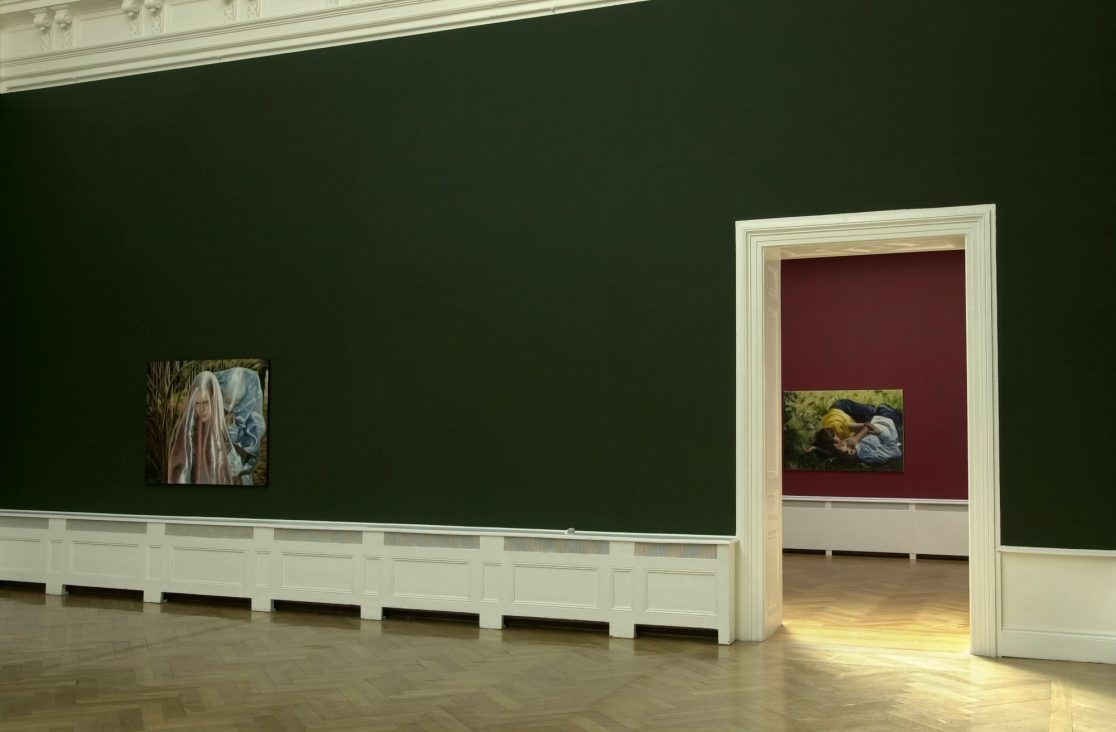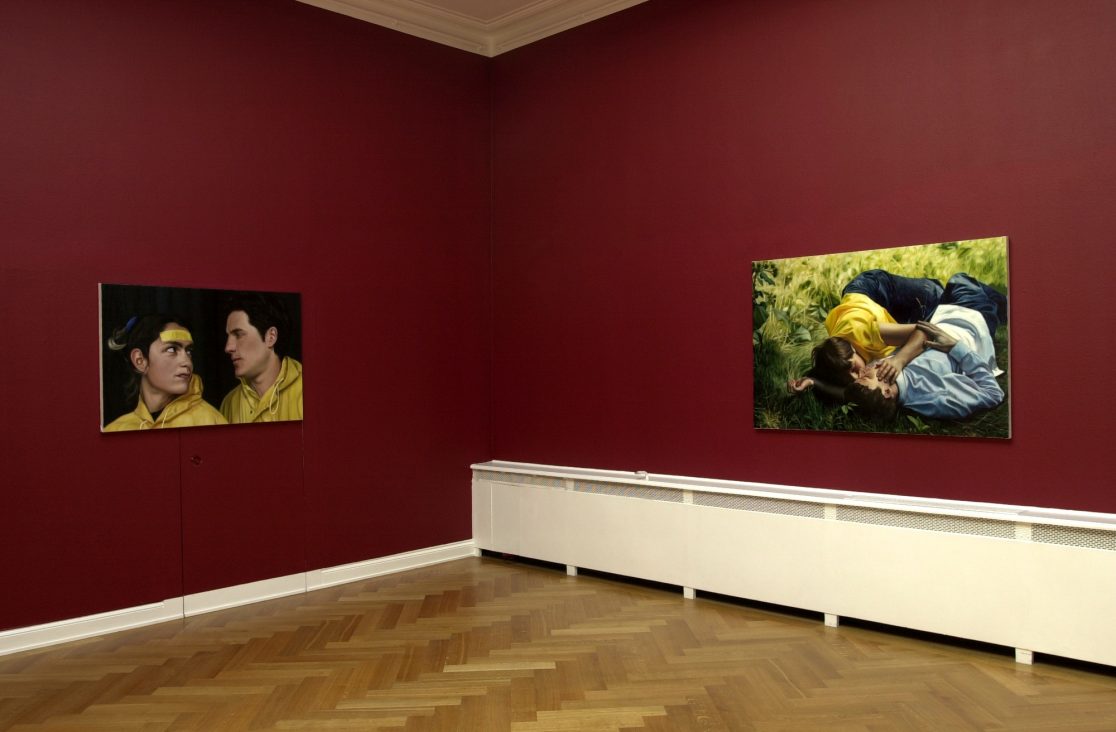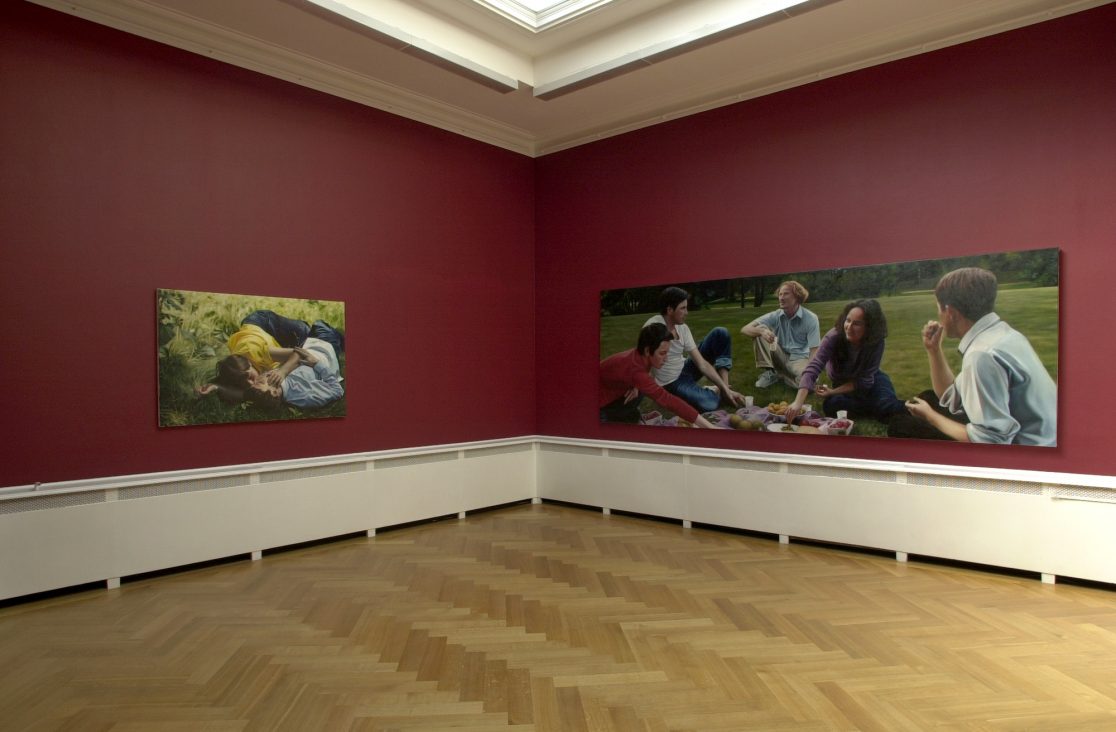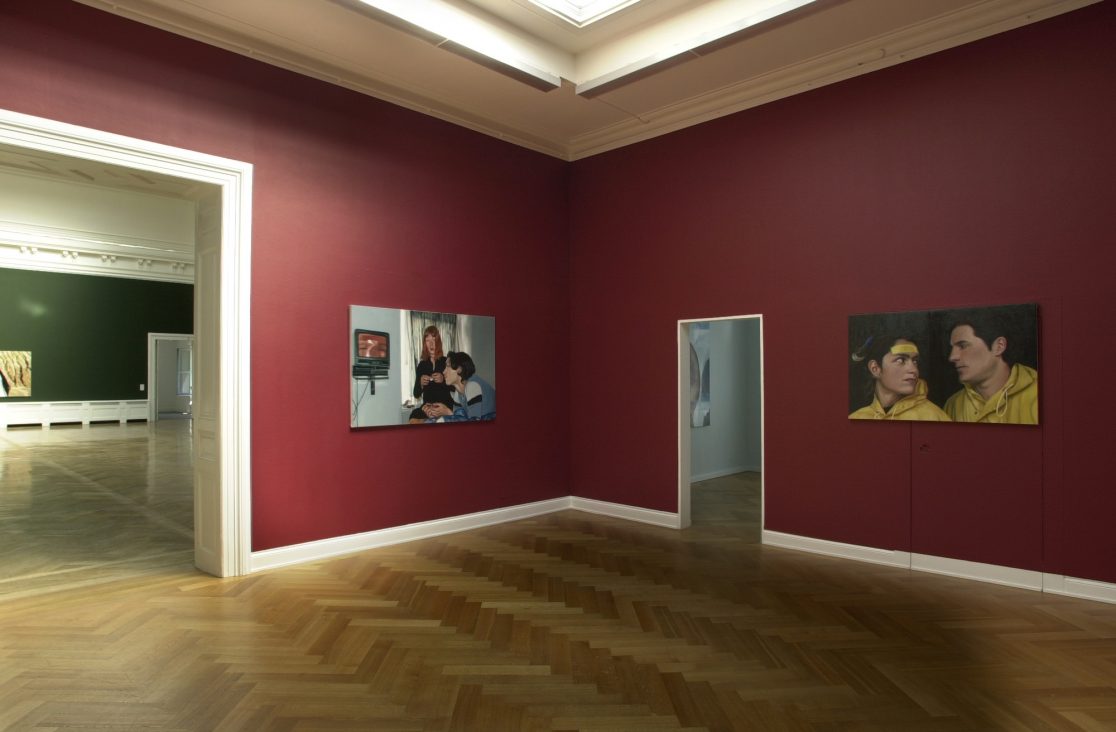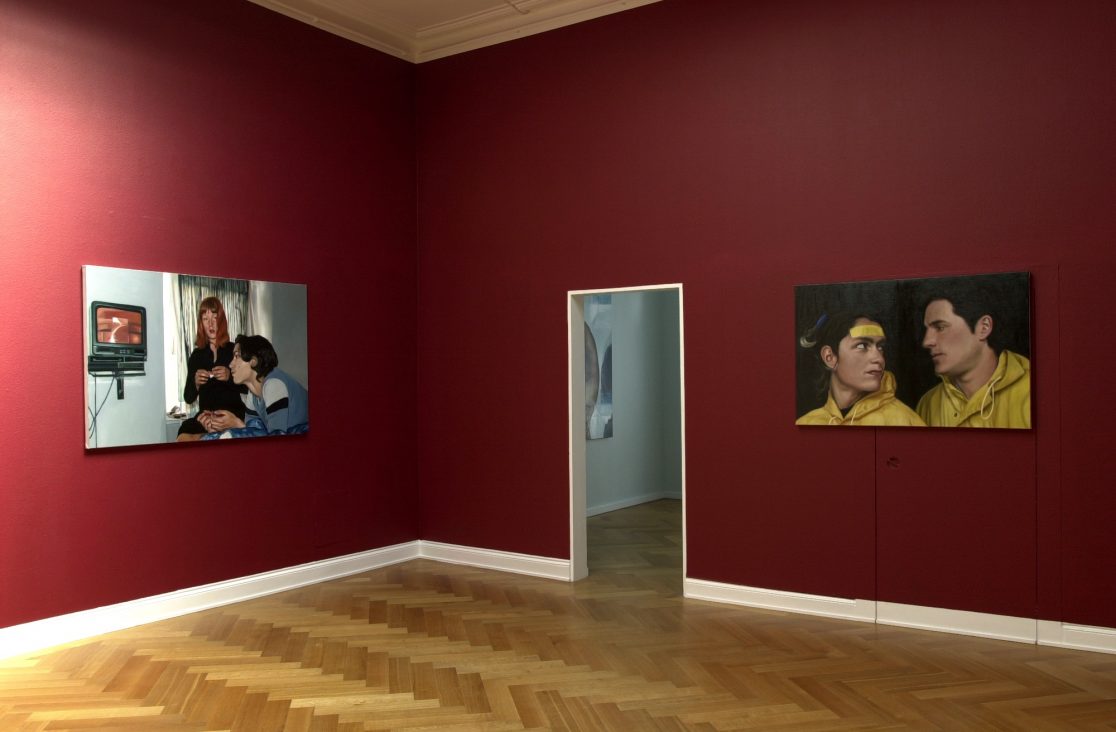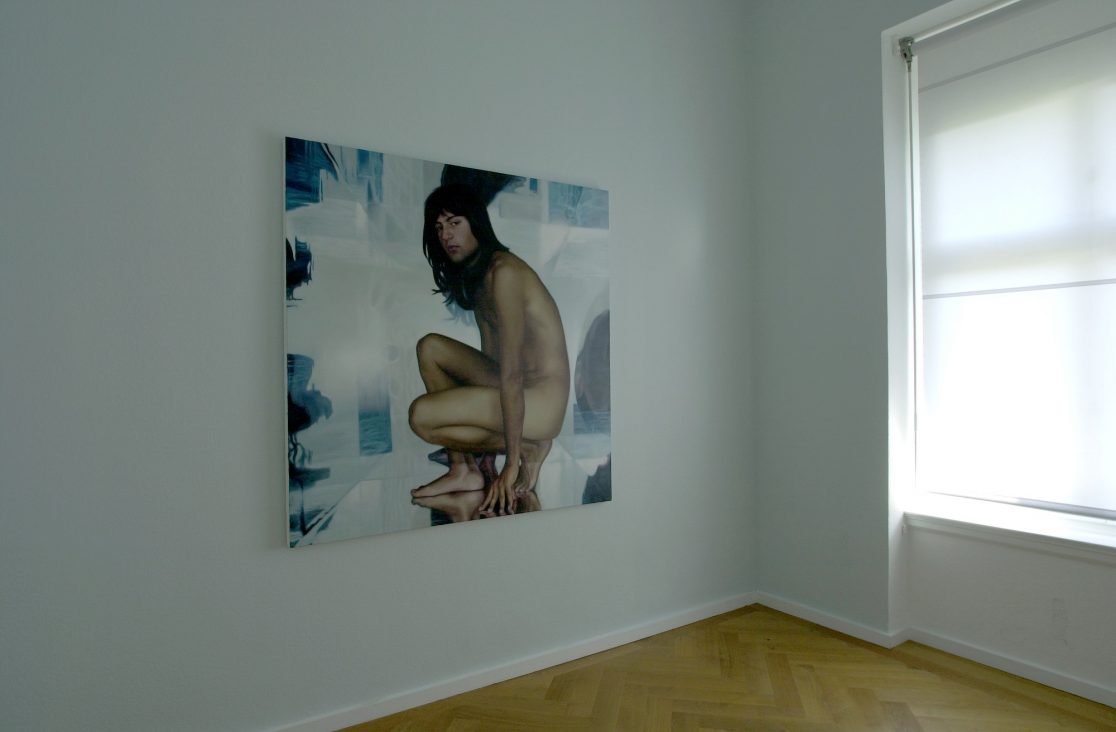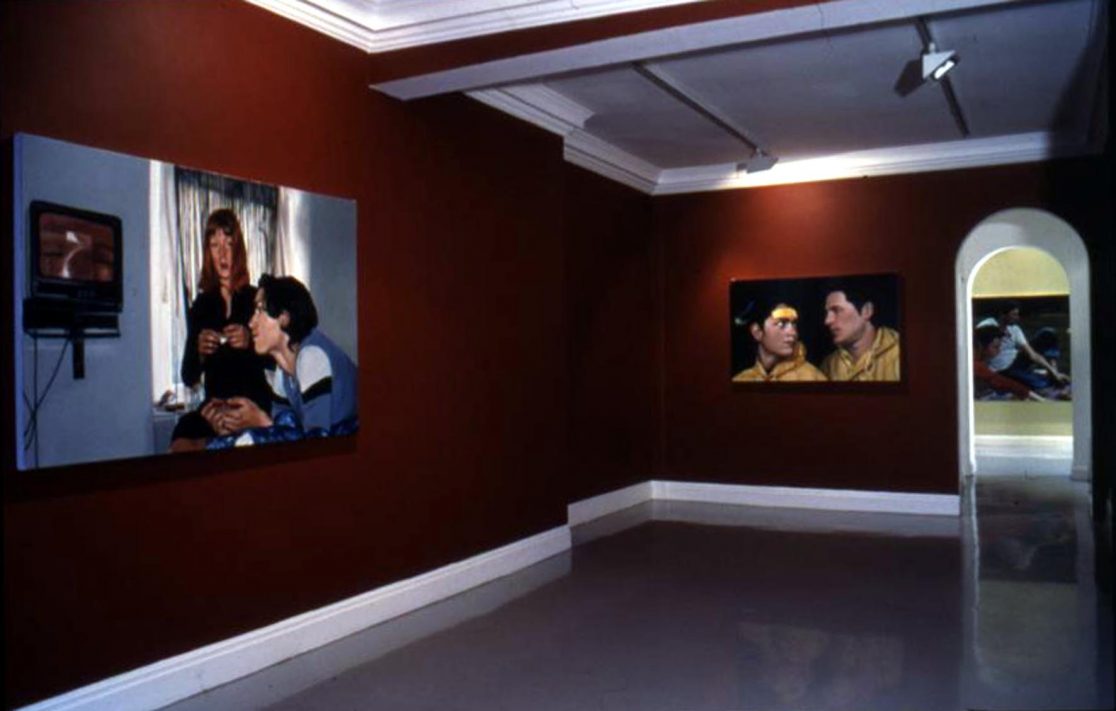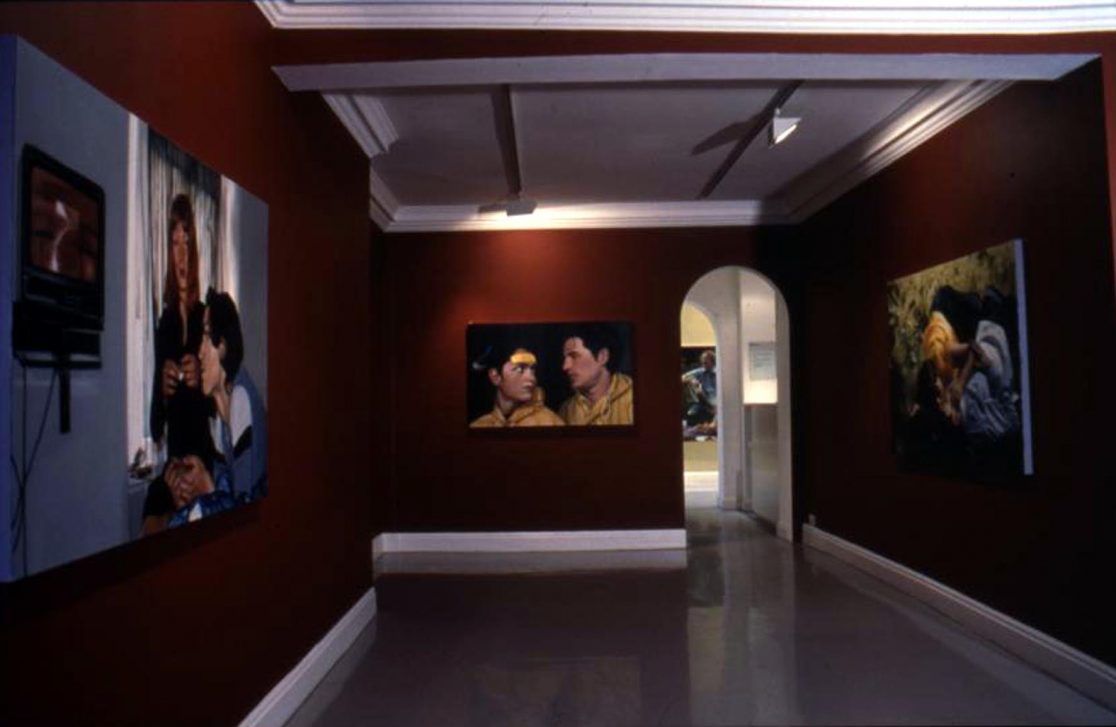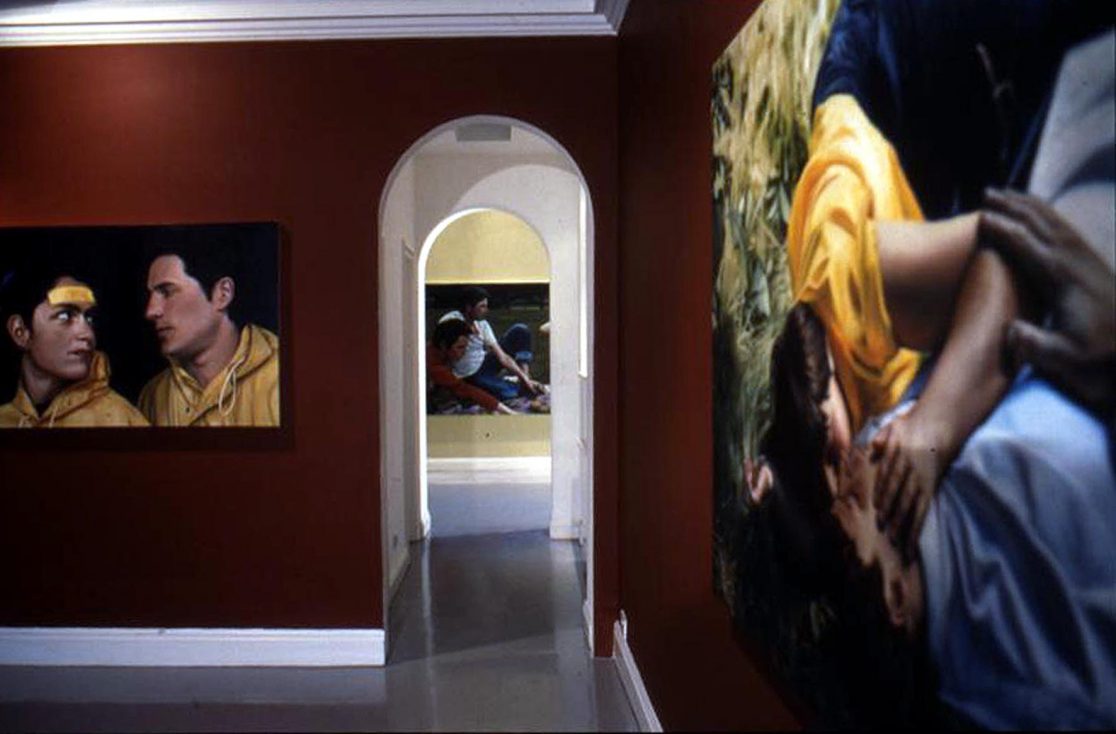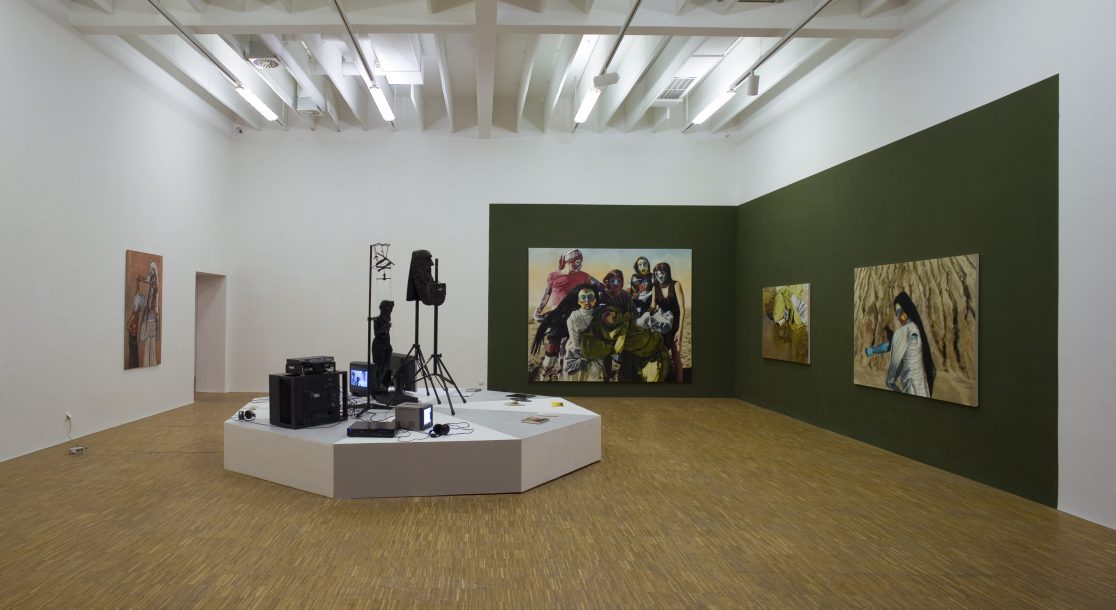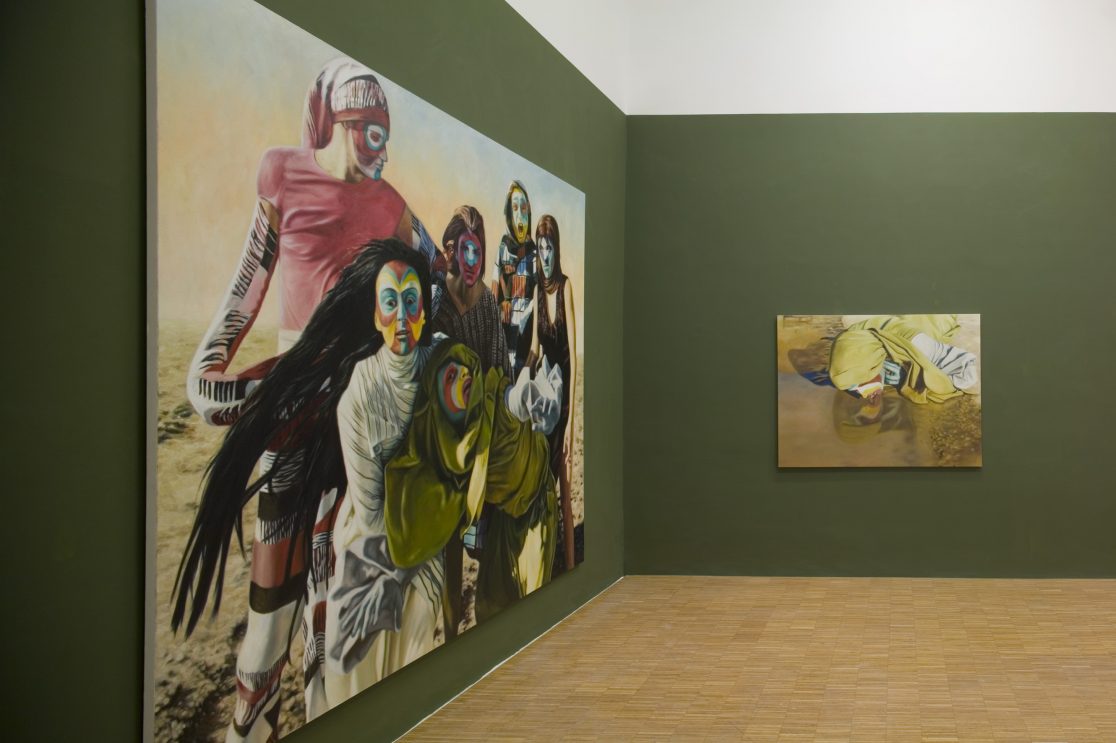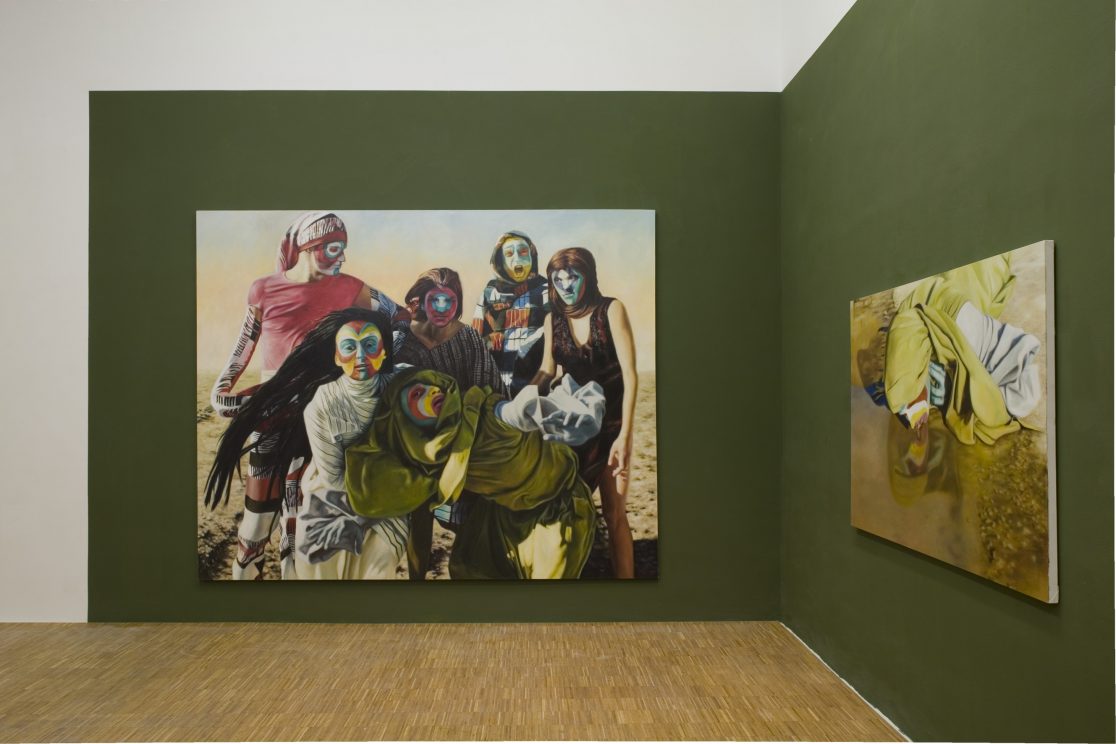L’Invitation au Voyage, 1999–2001
My series Invitation to a Voyage changes from two persons that are separate entities confronting each other, to a kind of Dionysian, orgiastic vision of equal beings that do things together. They are undistinguishable in terms of sex.
When I first staged the photos that I used for the paintings in Invitation to a Voyage, Part I: Friends and Lovers, I didn’t know the cycle would eventually evolve into four different series of paintings. My very first idea had been a sort of fête champêtre: couples in the green, having a picnic, running into the bushes for some erotic encounters. My models for Picknick were friends and acquaintances, and I found that my friends didn’t feel so much at ease in a public park. I then explored the tenseness between couples or friends in two more paintings and painted the rolling around in the green in Ingo und Antje. All paintings except the latter have people looking at each other, even scrutinizing each other, a relationship between perceiving and thinking beings. I intended to leave it open whether they were friends or lovers (or none of the two).[1]
No real people with possibly real relationships look at each other as we see in the first part. In Part 2: Liebling (Lovely) it is the viewer who gets involved with an alluring young man, naked, sitting in a mirror box, looking back at him. It’s a very attractive painting, even if someone doesn’t really respond to that kind of person.
For Part 3, (Geister) Ghosts, I went back to the idea of loving couples in the green.[2] In Geister (Ghosts), I had a man-woman in a black rather gothic looking gown standing in a forest with lots of twigs.[3] On the left hand side, one sees some shiny ghosts gliding through the undergrowth, while at the back of the figure they’re already coming at him/her – or at the spectator. The man-woman in the wilderness is alone, but I see it as turned around and played with by mighty feelings.
Part 4: Masken (Masks) takes place in a sort of desert. Wildly costumed people get ready for… what? They’ve come to drag you… where? One falls exhausted into a puddle in the mud and licks it,[4] while gazing at himself.[5]The colors, which were very dark in Spiel, become extremely vivid and the movements aggressive.[6]
Each of the parts had a different wall colour I wanted it to be hung on: Part 1: Friends and Lovers on a wine red background; Lovely on a light blue wall; and the other two series on dark green wall.
Thank you:
For helping with the costumes: Dana Liebe, Dominic Eichler, Krylon SuperstarThe models: Fjodor W. Donderer, Dominic Eichler, Simonetta Bettine Ginelli, Julian Göthe, Katrin Vellrath, Doreen Kutzke, Rebekka Ladewig, Martine Maffetti, Ingo Mocek, Ingo Niermann, May Riegler, Fil Ruting, Krylon Superstar, Julia Voss, Ute Waldhausen
Texts:
Sebastian Cichocki, L.A.S.T.L.E.A.K. (In the mud)
Alexa Hennig von Lange, Innere Welten – Interior Worlds
Nach der Wirklichkeit
Tanja Widmann in conversation with Antje Majewski: À bruit secret, 2009
Tanja Widmann im Gespräch mit Antje Majewski: À bruit secret, 2009
Exhibitions:
My very gestures, Salzburger Kunstverein, Salzburg, AT, 2008
Daß die Körper sprechen, auch das wissen wir seit langem, Generali Foundation, Vienna 2004
The contemporary face – von Pablo Picasso bis Alex Katz, Deichtorhallen, Hamburg, DE 2001
L’Invitation au Voyage, Kunsthalle Basel, 2001
Salon, Delfina Project Space, London, GB, 2000
Rocaille, Shedhalle, Zürich, 2000
Malkunst, Fondazione Mudima, Milano, 2000
Invitation to a Voyage, asprey jacques, London 1999
Catalogues:
Hemma Schmutz, Caroline Schneider (Ed.), Antje Majewski: My Very Gestures, Salzburger Kunstverein und Sternberg Press, Salzburg, Berlin, New York, 2008
Hemma Schmutz und Tanja Widmann (Ed.), Daß die Körper sprechen, auch das wissen wir seit langem.*, Generali Foundation, Wien, Verlag der Buchhandlung Walther König, Köln, 2004
Peter Pakesch (Ed.), Antje Majewski, L’Invitation au voyage, Kunsthalle Basel, Schwabe Verlag 2001
Birgit Hoffmeister, Malkunst, Fondazione Mudima, Milano 2000
[1] I had quite a lot of sources I could tap for my attempt at depicting relationships. My starting point was the huge paintings Sylvia Sleigh had been working on for two decades.
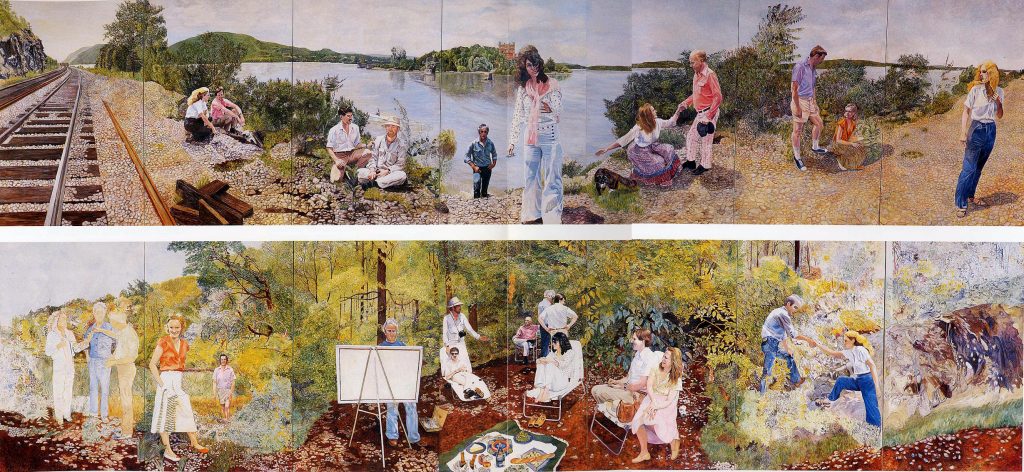 Sylvia Sleigh, Invitation to a Voyage. The Hudson River at Fishkill (1979-99)
Sylvia Sleigh, Invitation to a Voyage. The Hudson River at Fishkill (1979-99)
Sleigh had invited her friends from New York to come along to an excursion, one sunny afternoon in the seventies. It resulted in two paintings: Wood Side, a picnic in the woods, someone has put up an easel; and River Side, in which the friends stand by the banks of the river, a tiny island in the background; one woman is stretching out her hands as if to draw the spectator into the canvas. Sleigh’s title was taken from a poem by Charles Baudelaire (1821-1867), from Les fleurs du mal (1857)[1], in which he invites a lover to come with him to a strange and beautiful country full of „luxe, calme et volupté“.
Charles Baudelaire
L’Invitation au Voyage
Mon enfant, ma soeur,
Songe à la douceur
D’aller là-bas vivre ensemble !
Aimer à loisir,
Aimer et mourir
Au pays qui te ressemble !
Les soleils mouillés
De ces ciels brouillés
Pour mon esprit ont les charmes
Si mystérieux
De tes traîtres yeux,
Brillant à travers leurs larmes.
Là, tout n’est qu’ordre et beauté,
Luxe, calme et volupté.
Des meubles luisants,
Polis par les ans,
Décoreraient notre chambre;
Les plus rares fleurs
Mêlant leurs odeurs
Aux vagues senteurs de l’ambre,
Les riches plafonds,
Les miroirs profonds,
La splendeur orientale,
Tout y parlerait
À l’âme en secret
Sa douce langue natale.
Là, tout n’est qu’ordre et beauté,
Luxe, calme et volupté.
Vois sur ces canaux
Dormir ces vaisseaux
Dont l’humeur est vagabonde;
C’est pour assouvir
Ton moindre désir
Qu’ils viennent du bout du monde.
Les soleils couchants
Revêtent les champs,
Les canaux, la ville entière,
D’hyacinthe et d’or;
Le monde s’endort
Dans une chaude lumière.
Là, tout n’est qu’ordre et beauté,
Luxe, calme et volupté.
From Les fleurs du mal (1857)
Sleigh apparently identified this country with the island of Cythera, a Greek island that was the mythical birthplace of Venus and was turned into the destination for the pilgrims of love in the famous painting by Antoine Watteau (1684-1721), L’Embarquement pour l’île de Cythère, of which he painted several versions. I was of course very familiar with the version of 1717/18 that is owned by Schloss Charlottenburg in Berlin.
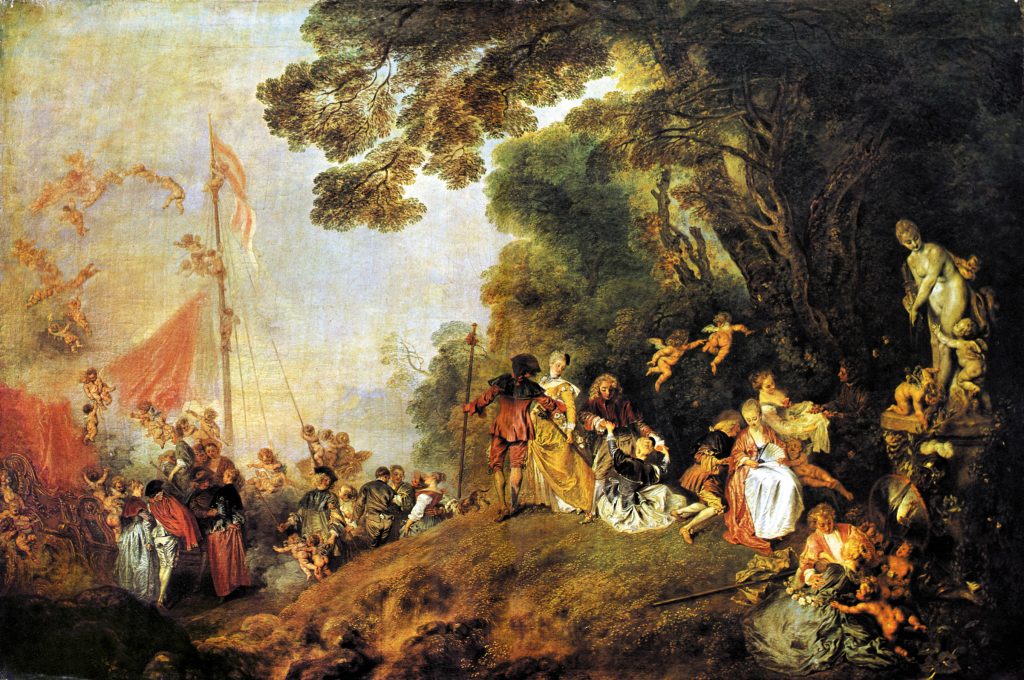
Antoine Watteau, L’Embarquement pour l’île de Cythère, 1717/18
In a Rococo park with great trees towering over the delicately dressed little figures, couples hold hands on the way down to the shore, where a small ship adorned with flowers is waiting to take them over to the island of Cythera.
[2] Even in Watteau’s painting, the giant trees always struck me as somewhat gloomy, so much more enduring and powerful then the tiny human beings. But it’s not only the plants size; it’s the wind that is blowing through them.
[3] My model was Krylon Superstar, a gay performer from New York who had designed the dress himself. He also danced in one of my films for Video. Featuring Sarah Mucaria and Krylon Superstar.
[4] Ingo Niermann suggested this scene, when he saw a muddy puddle in the sand hills we climbed onto. These hills were actually right behind our house; the railways were being rebuilt. Ingo remembered a scene from a Thomas Mann novel, Der Erwählte, which I had read when I was about sixteen and told him about. This novel, not one of Thomas Mann’s most popular ones, tells the story of a pope against will. He was the result of sex between brother and sister; and he later marries his own mother, which further complicates things. To punish himself he pays someone to row him to a bare island, chain him onto the rocks and throw the key into the water. He survives only because the rocks start producing a milky fluid that proves to be very nutritious. He bows over a little puddle of this fluid and starts drinking; afterwards he feels strangely satisfied and tired.
„Der Trank schmeckte zuckerig-leimig, nach Stärke etwas, etwas würzig nach Fenchel, dazu metallisch nach Eisen. Gregorius hatte gleich das Gefühl, daß durch ihn dem Durste nicht nur, sondern auch dem Hunger Genüge geschah, und zwar überraschend gründlich. Er war satt. Leicht stieß es ihm auf, und etwas von dem Getrunkenen floß ihm aus dem Munde wieder hervor, als sei das wenige schon zuviel gewesen. Er fühlte sein Gesicht ein wenig gedunsen, eine rötende Wärme stieg in seine Wangen, und als er zu seinem ersten Platz am Rande des Steines kriechend zurückgekehrt war, fiel er, den Kopf auf eine niedrige Stufe des Felsens gelegt, wie ein Kind in Schlaf.“ Thomas Mann, Der Erwählte, 1951
Over the years his beard and hair grow, while his body shrinks; and when the delegation comes to make him pope he has diminished to a hairy thing that is about as big as a child.
[5] Which is of course the second Narkissos in the series, after Lovely, who mirrors himself in the spectator.
Narkissos, a very beautiful young man, rejected the love of both the nymph Echo and the youth Ameinios, fell in love with his own image, mirrored in the water of a spring, and finally killed himself.
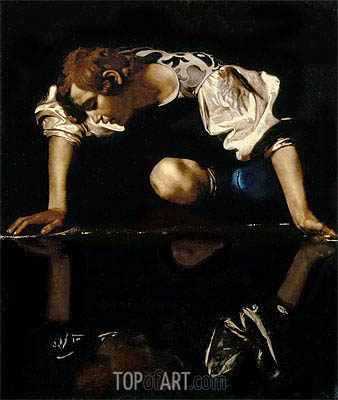
Michelangelo da Caravaggio, Narcissus, um 1600
Lesser known is a variation in which he had a twin sister and was actually in love with her. They wore the same clothes and hair and went hunting together. When his sister died, he kept looking into the water because in his own image he saw the shadow of his sister. See: Friedrich Wieseler, Narkissos. Eine kunstmythologische Abhandlung nebst einem Anhang über die Narcissen und ihre Beziehung im Leben, Mythos und Cultus der Griechen, Göttingen 1856
[6] Again more or less subconsciously I had various things in mind:
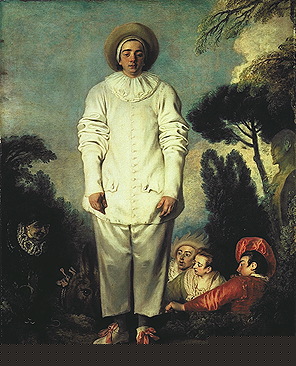
Antoine Watteau, Gilles, 1719
I bought the cloth for the costumes thinking about Bonnard, and about Watteau’s scary and sad harlequin; I also remembered the Matisse painting that took it’s title from the refrain of Baudelaire’s poem, Luxe, Calme et Volupté. Like in this painting I wanted to have a landscape gleaming in the sun, in yellow and red tones.

